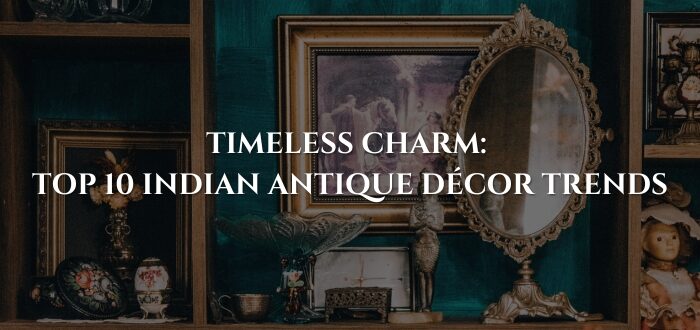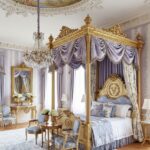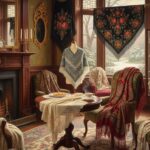Timeless Charm: Top 10 Indian Antique Décor Trends
Imagine entering a home and being transported to another era! That is the magic of antique Indian furniture and decorative arts. Indian antique home decor is more than just beautiful furnishings—it’s a connection to history, culture, craftsmanship, and timeless design. From intricately carved vintage wooden furniture to antique brass artefacts to hand-painted vases and more, Indian home decor has many facets and trends for every living space. With a rise in interest in these vintage pieces, the quest to find genuine antiques is on the rise. Online auction houses like Giftex play an important role in curating trusted antique items and help buyers get authentic pieces. In this guide, we explore the essence of Indian antique Indian furniture and home decor trends and have a look at the top 10 types of Indian antiques to elevate your space.

Top 10 Indian Antique Home Decor Ideas
Here are the top 10 ideas for Indian antique home decor trends: from furniture to wall art, to elevate any living space
- Wooden Furniture
Origin
Indian furniture has deep roots in Indian architectural traditions, with regional variations emerging across Rajasthan, Tamil Nadu, and Gujarat.
Some Popular Types
Diwans: A diwan, also known as a daybed, is a long, low seating option, with elaborate carvings.
Jhula: A traditional swing found in many Indian homes, especially in Gujarat and Rajasthan and Tamil Nadu.
Charpai: A traditional bed made of a wooden frame with woven ropes or strings.
Painted Trunks: Rajasthani style painted trunks featuring elephants, camels, peacocks and others in vibrant hues.
Craftsmanship
Floral, mythological motifs, etc., are hand-carved using traditional tools.
Decor Tip
Place a carved wooden trunk at the foot of your bed for both storage and vintage appeal. Alternatively, use a carved screen or partition to define spaces within an open layout.
Also Read: Types of Indian Furniture
- Brass and Copper Artefacts
Origin
Brass artefacts hailing from South India, Maharashtra, and parts of Uttar Pradesh are deeply influenced by temple traditions.
Some Popular Types
Idols: Brass idols of deities like Ganesha, Krishna.
Lamps: Diyas and other types of lamps, used as decorative items.
Vases and Bowls: Decorative vases, bowls, and urulis with intricate designs.
Significance
Brass and copper artefacts represent a rich cultural heritage, with traditions passed down through generations of artisans.
Decor Tip
Place a brass urli filled with water and petals at your entrance for a traditional welcome.

- Dhokra Art: Tribal Metal Craft
Origin
Dhokra art originates from tribal regions in Odisha, West Bengal, and Jharkhand, with historical roots tracing back over 4,000 years.
Style and Era
This form of metal casting dates to the Indus Valley Civilization, using the lost-wax method.
Craftsmanship
Each piece is handcrafted without molds. Artisans sculpt a clay core, wrap it in beeswax threads, and then encase it in clay. When fired, the wax melts, and molten metal is poured into the cavity to form the sculpture.
Cultural Significance
Dhokra items often depict tribal deities, musicians, animals, and scenes from village life, serving as visual narratives of indigenous cultures.
Decor Tip
Use Dhokra figures as statement objects on console tables or bookshelf displays.
- Bidriware Artefacts
Origin
Bidriware comes from Bidar, Karnataka, with its techniques perfected under the Bahmani Sultanate in the 14th century.
Craftsmanship
Bidriware, an ancient metalwork technique from Bidar, Karnataka, produces exquisite artifacts adorned with intricate silver inlay work.
Decor Tip
Display them as standalone pieces or use them to showcase fresh flowers or decorative accents on your dining table or sideboard.

- Jaipur Pottery: Colorful and Vibrant
Origin
Jaipur, became a center for pottery under the patronage of Maharaja Sawai Ram Singh II in the 19th century.
Style and Era
Known for Blue Pottery and painted terracotta, this style blends Mughal and Persian influences.
Craftsmanship
Artisans shape clay or quartz-based materials, painted with natural dyes.
Cultural Significance
Jaipur pottery represents the region’s artistic spirit. Blue Pottery is especially prized for its aesthetic appeal.
Decor Tip
Group three or five ceramic pieces of varying sizes on a mantel or shelf.
- Bastar Iron Art
Origin
Originating from the Bastar region of Chhattisgarh, this iron art is a long-standing tradition among tribal communities.
Style and Era
Developed over centuries, this artform uses black wrought iron shaped into dynamic, expressive figures.
Craftsmanship
The iron figures are often abstract representations of tribal life, rituals, and folklore.
Cultural Significance
These sculptures reflect the lifestyle, spirituality, and beliefs of the Bastar tribes, celebrating dance, music, and agriculture.
Decor Tip
Use Bastar figurines in entryways or pair standing sculptures with minimalist interiors.

- Warli Art
Origin
Warli art originates from the Warli tribe in Maharashtra, India. It is deeply rooted in the rural lifestyle of the tribal community.
Style and Era:
This tribal art dates back thousands of years and is still practiced today.
Craftsmanship
Warli art is created using white rice paste or chalk on a red ochre background. It features geometric patterns and depicts rural scenes.
Cultural Significance:
These paintings are a visual record of tribal customs and beliefs. They often depict harmony with nature and community celebration.
Decor Tip:
Incorporate Warli art as a mural or framed canvas in living spaces or hallways.
- Flower Vases from Uttar Pradesh
Origin
These hand-painted ceramic vases originate from the culturally rich state of Uttar Pradesh, particularly in regions like Khurja, which have long been hubs of ceramic artistry.
Style and Era:
The tradition of ceramic pottery in this region dates back several centuries, with Mughal-era influences visible.
Craftsmanship
Each vase is crafted by shaping natural clay on a potter’s wheel, then hand-painted. Artisans incorporate floral motifs, traditional paisleys, and geometric borders before glazing and firing the piece for durability.
Cultural Significance
These vases symbolize beauty, prosperity, and artistic expression.
Decor Tip:
Place a vase on a console or windowsill filled with wildflowers or tall reeds.
Also Read: Meaning of Motifs In Decorative Arts
- Indian Tribal Masks
Origin
These artisanal pieces come from the tribal heartlands of India, including Madhya Pradesh, Chhattisgarh, Odisha, and Nagaland.
Craftsmanship
Tribal masks and hand-carved décor items are typically crafted from locally sourced wood, clay, bamboo, or metal.
Cultural Significance:
These handcrafted items are more than just decorative—they carry deep spiritual and cultural meaning.
Decor Tip
Use tribal masks as statement pieces in minimalist or rustic interiors.
- Indian Jali Panels & Works
Origin
Indian jali work comes from the culturally rich regions of Gujarat, especially Kutch, Bhuj, and the historic havelis of old Ahmedabad
Craftsmanship
Jali work involves the intricate carving of wood into perforated patterns that allow air and light to pass through while adding ornamental beauty.
Key Types:
Wooden Jali Windows: Lattice panels designed to filter light and cast patterned shadows.
Carved Door Frames: Elaborate frames adorned with birds, floral motifs, and mythic storytelling elements.
Wall Brackets: Functional yet decorative support elements.
Cultural Significance
Originally used in havelis and temples, jali panels were designed to maintain privacy and cool interiors.
Decor Tip:
Use jali panels as focal points in modern homes—frame one as wall art or use it as a door frame to add texture and character.
Begin Your Journey Today
The journey to elevate your living space with unique, culturally rich Indian home accessories begins with thoughtful curation. Our list of the Top 10 Indian Home Décor Items to Elevate Your Living Room is more than just inspiration—it’s your gateway to discovering the depth and diversity of Indian artistry. Whether you’re drawn to intricate Indian jail panels or Indian tribal masks or timeless antique brass artefacts, search for meaningful decor is endlessly rewarding.
Let every piece you choose tell a story worth sharing…






